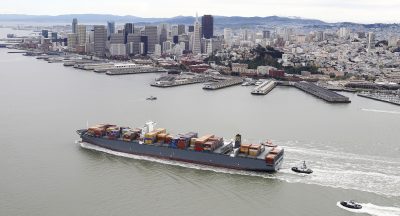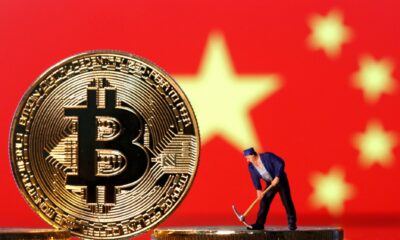Trade
Investing in port infrastructure for America’s post-COVID-19 recovery

Author: Gary Clyde Hufbauer, PIIE
US President Joe Biden’s next big legislative push is an infrastructure bill that will top US$2 trillion. The President has broadly defined ‘infrastructure’ to include schools, housing for the elderly and much else besides the classic ingredients of roads, bridges and ports. While the total price tag is huge, constituencies in both the Democratic and Republican parties will jockey for their favourite projects, so some needs will be short-changed.
Even with a price tag in the tens of billions, enlarging ports on the US West Coast should be a priority for Biden. Dozens of container ships are currently idled awaiting berths off Long Beach and Los Angeles, the two busiest and biggest West Coast ports, and many are instead routed north to Oakland and Seattle.
Sceptics may question whether such spending is justified, pointing to former president Donald Trump’s trade war with China (now embraced by Biden) and the ‘Buy American’ trend. Perhaps rhetorically, the age of globalisation has passed and with it the need for ever more shipping berths and connecting roads and rails. But the powerful economic drivers of globalisation, though tempered by nationalism and the COVID-19 pandemic, will continue to enlarge shipping volumes for at least the next decade. This includes eye-catching cost differences between the United States, Asia and Latin America, which are reinforced by factors such as technological differentials, product varieties, quality distinctions and production schedules.
The US–China trade war will alter sources of supply and ‘Buy American’ will shorten supply chains and raise prices. Yet while political obstacles can dampen trade, they cannot decouple the United States from the world economy.
Before the trade war kicked off in 2018, US imports of goods from Asia through the Long Beach and Los Angeles ports had increased steadily since 2010. On average, the volume of US purchases of Chinese goods grew by 3.6 per cent every year between 2010 and 2017. Goods supplied by Asia excluding China grew at an even faster pace, with an average growth rate of 4.8 per cent every year.
The trade war initially increased US demand for Chinese goods as companies front-loaded to avoid paying higher tariffs. But as these tariffs took effect, Chinese products began to lose their competitive advantage in the US market. The volume of US imports from China through the Long Beach and Los Angeles ports went up 6.2 per cent in 2018 before dropping 17.7 per cent in 2019. The trade war had little effect on US imports from other Asian countries, which grew 4.7 per cent in 2019 after experiencing a mild decline in 2018.
Even if Biden were to ramp up the trade war with China — for now an unlikely prospect — it would not necessarily depress shipping volumes from Asia to the West Coast ports. The AmCham China survey indicates that most businesses departing China will look to go elsewhere in Asia, not return production to North America.
COVID-19 shocked the global economy in 2020. Surprisingly, as China was the first to bring the virus under control and resume economic activity, US imports from China through Long Beach and Los Angeles grew in 2020, partially owing to the surge in demand for personal protective equipment.
As vaccines roll out in the United States and around the globe, the US economy will further recover and production capacity will rebound in other Asian countries excluding China. US imports from these countries may well return to the pre-COVID-19 level later this year and continue growing at their pre-COVID-19 pace for the rest of the decade.
Supply chain disruptions on road and rail links from West Coast ports may be partly responsible for the spectacle of container ships idled off Long Beach and Los Angeles and in San Francisco Bay. But such disruptions are likely to be resolved as truck drivers and rail crews return to work, but the more serious problem of inadequate port capacity will take longer to address.
This makes the case for massive infrastructure enlargement in Long Beach, Los Angeles and other West Coast ports. Port projects generally take longer than initial forecasts, so a legislative green light in 2021 will not translate to significant new capacity for at least three or four years. Shipping backlogs seen in news media photos today will likely persist for months, if not years. US port enlargement needs to move ahead now at full speed.
Gary Clyde Hufbauer is a Non-Resident Senior Fellow at the Peterson Institute of International Economics.
The post
Trade
Self-Reliance and Openness: Core Principles of China’s Third Plenary Session

The Third Plenum communique from the CCP indicates a prioritization of stability and compromise in response to China’s economic challenges. It highlights the concept of Chinese-style modernization and establishes political guidelines for balancing regulation and market forces.
The CCP’s Third Plenum communique signals a focus on stability and compromise in the face of China’s economic challenges. It emphasises Chinese-style modernisation and sets political directions for balancing regulation and market forces. While not as groundbreaking as previous plenums, it acknowledges the importance of market mechanisms and technological self-reliance, aiming to address issues like high youth unemployment and private sector uncertainty. The communique seeks to navigate the complexities of global competition and domestic innovation, potentially reshaping global supply chains and trade dynamics. Overall, it presents a pragmatic blueprint for China’s economic future.
Source : Self-reliance and openness central pillars of China’s Third Plenum | East Asia Forum
Trade
Trade Prevails Over Political Persuasions in China-Germany Relations

China and Germany maintain a strong bilateral relationship, rooted in economic cooperation despite ideological differences. Recent visits and agreements focus on expanding trade and addressing mutual concerns, navigating challenges while nurturing ties.
Evolving Bilateral Ties
China and Germany share a strong bilateral relationship, rooted in history since 1972. This connection has seen moments of cooperation intertwined with periods of tension. German Chancellor Olaf Scholz’s April 2024 visit underscores Germany’s commitment to fostering this partnership, reflecting a mutual interest in maintaining economic ties despite ideological differences.
Economic Pragmatism
As the second and third largest global economies, China and Germany’s economic interdependence is crucial. Germany emerged as China’s primary trading partner in 2023, with trade values reaching €254.4 billion (US$280 billion). In response to global scrutiny, Germany has taken a balanced approach, emphasizing economic stability over political discord. This was evident during Scholz’s prior visit in November 2022, where his diplomatic tone contrasted with broader EU sentiments.
Facing Challenges Together
Despite increasing public skepticism in Germany regarding China’s global influence and human rights issues, both nations continue to seek common ground. Their October 2023 Joint Statement highlights intentions to pursue cooperation in areas like carbon neutrality and open markets. To navigate these complex terrains, Germany can utilize its institutional frameworks to enhance dialogue, while also considering supply chain diversification to reduce dependency on China. The intertwining nature of their economies suggests that, despite challenges, both countries will continue to prioritize their substantial trade relations.
Source : Trade trumps political persuasions in China–Germany relations
Trade
Fixing fragmentation in the settlement of international trade disputes

Fragmentation in global trade due to the lack of development in multilateral trade rules at the WTO has led to an increase in FTAs. The Appellate Body impasse has further exacerbated fragmentation, requiring a multilateral approach for reform.
Fragmentation in Global Trade
Fragmentation in global trade is not new. With the slow development of multilateral trade rules at the World Trade Organization (WTO), governments have turned to free trade agreements (FTAs). As of 2023, almost 600 bilateral and regional trade agreements have been notified to the WTO, leading to growing fragmentation in trade rules, business activities, and international relations. But until recently, trade dispute settlements have predominantly remained within the WTO.
Challenges with WTO Dispute Settlement
The demise of the Appellate Body increased fragmentation in both the interpretation and enforcement of trade law. A small number of WTO Members created the Multi-Party Interim Appeal Arbitration Arrangement (MPIA) as a temporary solution, but in its current form, it cannot properly address fragmentation. Since its creation in 2020, the MPIA has only attracted 26 parties, and its rulings have not been consistent with previous decisions made by the Appellate Body, rendering WTO case law increasingly fragmented.
The Path Forward for Global Trade
Maintaining the integrity and predictability of the global trading system while reducing fragmentation requires restoring the WTO’s authority. At the 12th WTO Ministerial Conference in 2022, governments agreed to re-establish a functional dispute settlement system by 2024. Reaching a consensus will be difficult, and negotiations will take time. A critical mass-based, open plurilateral approach provides a viable alternative way to reform the appellate mechanism, as WTO Members are committed to reforming the dispute settlement system.
Source : Fixing fragmentation in the settlement of international trade disputes






